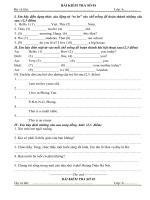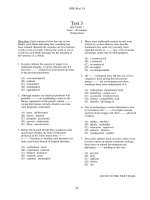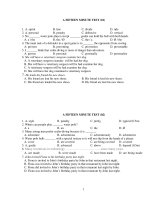Test 03 1 Test 03 1 Test 03 1 Test 03 1 Test 03 1 Test 03 1 Test 03 1
Bạn đang xem bản rút gọn của tài liệu. Xem và tải ngay bản đầy đủ của tài liệu tại đây (29.98 KB, 6 trang )
GRE Real 19
Test 3
SECTION 1
Time— 30 minutes
38 Questions
Directions: Each sentence below has one or two
blanks, each blank indicating that something has
been omitted. Beneath the sentence are five lettered
words or sets of words. Choose the word or set of
words for each blank that best fits the meaning of
the sentence as a whole.
4. Many more eighteenth-century novels were
written by women than by men, but this
dominance has, until very recently, been
regarded merely as ------- fact, a bit of arcane
knowledge noted only by bibliographers.
(A)
(B)
(C)
(D)
(E)
1. In some cultures the essence of magic is its
traditional integrity: it can be efficient only if it
has been ------- without loss from primeval times
to the present practitioner.
(A)
(B)
(C)
(D)
(E)
5. All ------- biological traits fall into one of two
categories: those giving their possessors
greater ------- the environment and those
rendering them more independent of it.
conventionalized
realized
transmitted
manipulated
aggrandized
(A)
(B)
(C)
(D)
(E)
2. Although skeptics say financial problems will
probably ------- our establishing a base on the
Moon, supporters of the project remain -------,
saying that human curiosity should overcome
such pragmatic constraints.
(A)
(B)
(C)
(D)
(E)
widespread. .detachment from
beneficial. .control over
successful. .freedom from
neutral. .compatibility with
harmful. .advantage in
6. One of archaeology's central dilemmas is now
to reconstruct the ------- of complex ancient
societies from meager and often ------- physical
evidence.
beset. .disillusioned
hasten. .hopeful
postpone. .pessimistic
prevent. .enthusiastic
allow. .unconvinced
(A)
(B)
(C)
(D)
(E)
3. Before the Second World War, academics still
questioned whether the body of literature
produced in the Unite States truly ------a ------- literature or whether such literature was
only a provincial branch of English literature.
(A)
(B)
(C)
(D)
(E)
a controversial
a statistical
an analytical
an explicit
an unimpeachable
riddles. .obsolete
details. .irrefutable
intricacies. .equivocal
patterns. .flawless
configuration. .explicit
7. Just as the authors' book on eels is often a key
text for courses in marine vertebrate zoology,
their ideas on animal development and
phylogeny ------- teaching in this area.
symbolized. .local
constituted. .national
defined. .historical
outlined. .good
captured. .meaningful
(A)
(B)
(C)
(D)
(E)
prevent
defy
replicate
inform
use
GO ON TO THE NEXT PAGE.
25
For more material and information, please visit www.tailieuduhoc
최영범esoterica어학원
Directions: In each of the following questions,
a related pair of words or phrases is followed by
five lettered pairs of words or phrases. Select the
lettered pair that best expresses a relationship
similar to that expressed in the original pair.
12. LIKEN : SIMILARITY ::
(A) classify : hierarchy
(B) hesitate : reluctance
(C) discriminate : difference
(D) argue : debate
(E) vacillate : decision
8. ILLUMINATE : DARKNESS ::
(A) educate : ignorance
(B) enlighten : scholarship
(C) liberate : freedom
(D) patronize : dignity
(E) protest : oppression
13. INSTIGATOR : INCITE ::
(A) accomplice : threaten
(B) adjudicator : quarrel
(C) employee : strike
(D) bully : browbeat
(E) lawyer : enact
9. INSTRUMENTALIST : ORCHESTRA ::
(A) dancer : choreographer
(B) actor : troupe
(C) conductor : baton
(D) singer : composition
(E) director : play
14. GLACIAL : COLD ::
(A) opaque : lucid
(B) viscid : liquid
(C) massive : lengthy
(D) profound : deep
(E) misshapen : flexible
10. BOWL : RECEPTACLE ::
(A) painting : masterpiece
(B) brick : mortar
(C) tumbler : crystal
(D) can : load
(E) bicycle : vehicle
15. NEPOTISM : RELATIVE ::
(A) cronyism : friend
(B) elitism : leader
(C) narcissism : self
(D) recidivism : criminal
(E) jingoism : patriot
11. CAVERN : SPELUNKER ::
(A) wood : carpenter
(B) horse : jockey
(C) machine : mechanic
(D) star : astronomer
(E) ocean : diver
16. LAW : CRIMINALITY ::
(A) ritual : orthodoxy
(B) leadership : submission
(C) consensus : factionalism
(D) lesson : falsehood
(E) rehabilitation : vacillation
GO ON TO THE NEXT PAGE.
26
For more material and information, please visit www.tailieuduhoc
GRE Real 19
Directions: Each passage in this group is followed by questions based on its content. After reading a passage, choose
the best answer to each questions. Answer all questions following a passage on the basis of what is stated or implied
in that passage.
National character is not formally considered by
social scientists in discussing economic and social
development today. They believe that people differ and
Line that these differences should be taken into account
(5) somehow, but they have as yet discovered no way to
include such variables in their formal models of economic and social development. The difficulty lies in the
nature of the data that supposedly define different
national characters. Anthropologists and others are on
(10) much firmer ground when they attempt to describe the
cultural norms for a small homogeneous tribe or village
than when they undertake the formidable task of discovering the norms that exist in a complex modern
nation-state composed of many disparate groups. The
(15) situation is further complicated by the nature of judgments about characters since such judgments are overly
dependent on impressions and since, furthermore,
impressions are usually stated in qualitative terms, it is
impossible to make a reliable comparison between the
(20) national characters of two countries.
19. It can be inferred from the passage that the social
scientists mentioned in lines 1-7 would agree with
which of the following statements?
I. It is extremely difficult to create models that
account for both economic and social
development.
II. Models of economic and social development
would be improved by the inclusion of adequate
descriptions of national character.
III. It is important to supplement formal models of
economic and social development with
qualitative impressions of national character.
(A) I only
(B) II only
(C) III only
(D) I and III only
(E) II and III only
20. Which of the following best describes the
organization of the passage?
17. The author's main point in the passage is that
national character
(A) is too elusive to merit attention by
anthropologists and other social scientists.
(B) is of greater interest to social scientists today
than it has been in the past
(C) is still too difficult to describe with the precision
required by many social scientists
(D) has become increasingly irrelevant because of
the complexity of modern life
(E) can be described more accurately by
anthropologists than by other social scientists
(A) A problem is presented and reasons for its
existence are supplied.
(B) A controversial view is presented and evidence
for its validity is supplied.
(C) A hypothesis is presented and possible means
of verifying it are suggested.
(D) recent development is described and then
analyzed.
(E) A dispute is summarized and one side
defended.
18. Given the information in the passage, which of the
following is NOT true of modern nation-states?
(A) They are complex.
(B) They are heterogeneous.
(C) They are of interest to social scientists.
(D) They lack cultural norms.
(E) They differ from one another in terms of
national character.
GO ON TO THE NEXT PAGE.
27
For more material and information, please visit www.tailieuduhoc
최영범esoterica어학원
One of the simplest and best known kinds of crystal
is the ionic salt of which a typical example is sodium
chloride, or ordinary table salt. The fundamental comLineponents of an ionic salt are ions: atoms or molecules
(5) that have become electrically charged by gaining or
losing one or more electrons. In forming sodium chloride for example, sodium atoms give up an electron
(thereby becoming positively charged) and chlorine
atoms gain an electron (thereby becoming negatively
(10) charged). The ions are attracted to one another by their
opposite charges, and they stack together compactly like
tightly packed spheres.
Recently, scientists at Michigan State University
created a new kind of crystal called an electride. In
(15) electrides, the anions (negative ions) are completely
replaced by electrons, which are trapped in naturally
formed cavities within a framework of regularly
stacked cations (positive ions). Electrides are the first
examples of ionic salts in which all these anionic sites
(20) are occupied solely by electrons.
Unlike other types of anions, anionic electrons do
not behave as if they were simple charged spheres. In
particular, because of their low mass and their tendency
to interact with one another over great distances, they
(25) cannot be "pinned down" to any one location. Instead,
they wander close to and among the atoms lining the
cavity and interact with electrons in nearby cavities,
perhaps changing places with them.
The properties of an electride depend largely on the
(30) distance between the cavities that hold trapped electrons. When the trapped electrons are far apart, they do
not interact strongly, and so behave somewhat like an
array of isolated negative charges. When they are
closer together, they begin to display properties associ(35) ated with large ensembles of identical particles. When
they are still closer, the ensemble properties dominate
and the electrons "delocalize": they are no longer
tightly bound within individual cavities but are more or
less free to pass through the spaces within the frame(40) work of positive ions.
By synthesizing electrides from a variety of materials, one can vary the geometry of the anionic cavities
and their relation to the surrounding cations. The
resulting properties may make it possible for electrides
(45) to become a basis for economically useful new materials and devices. For instance, because the electrons in
some electrides are very weakly bound, these crystals
could be effective as photosensitive detectors, in which
an impinging photon liberates an electron, resulting in
(50) a small electric current. The same weak binding could
also make electrides useful in solar-energy converters
and as cathodes in batteries. One obstacle is the tendency of electrides to decompose through reaction with
air and water. Researchers are seeking ways to increase
their stability.
21. The passage is primarily concerned with discussing
(A) a way to isolate electrons
(B) the characteristics of a new kind of crystal
(C) the structure of all ionic salt
(D) commercial uses or electrides
(E) the properties of ions
22. In the first paragraph, the author is primarily
concerned with
(A) introducing a variant on the standard atomic
theory
(B) describing how chlorine atoms can become
negatively charged
(C) describing some early research at Michigan
State University
(D) presenting the identifying properties of an
electride
(E) providing background for the technical
discussion to follow
23. It can be inferred from the passage that the
differences between the behavior of anionic
electrons and normal anions result from which of the
following features of electrons as compared to
normal anions?
I. The much lower mass of electrons
II. The much greater tendency of electrons to
interact with one another over large distances
III. The much greater likelihood of electrons to
remain trapped in naturally formed anionic
cavities
(A) I only
(B) II only
(C) I and II only
(D) I and III only
(E) II and III only
24. According to the passage, the defining characteristic
of an electride is which of the following?
(A) Its positive ions are of particularly low mass.
(B) Its ions possess identical electrical stacked
ions.
(C) It contains a framework of regularly stacked
ions.
(D) Its ions demonstrate strong mutual attraction.
(E) Its negative ions consist solely of electrons.
GO ON TO THE NEXT PAGE.
28
For more material and information, please visit www.tailieuduhoc
GRE Real 19
25. It can be inferred from the passage that anions
behaving as "simple charged spheres''(line 22) could
be expected to
27. With which of the following statements regarding
electrides would the author most likely agree?
(A) They have proven themselves to be of great
commercial value.
(B) Their future commercial value is promising but
uncertain.
(C) They are interesting but of no practical value.
(D) They have commercial value mainly in solar
energy applications.
(E) Their principal importance will lie in scientific
research.
(A) readily lose electrons and become positively
charged
(B) move freely in and out of their cavities
(C) respond to photons by liberating electrons
(D) stack with other anions to create a regular
framework
(E) remain fixed relative to their cations
26. It can be inferred from the passage that an electride
behaves most like a normal ionic crystal when the
electride has which of the following features?
(A) The anionic cavities are widely separated.
(B) All of the trapped electrons are able to
delocalize.
(C) The trapped electrons are liberated by
impinging photons.
(D) The ions are tightly packed together.
(E) Most of the cations have lost their electrical
charge.
GO ON TO THE NEXT PAGE
29
For more material and information, please visit www.tailieuduhoc
최영범esoterica어학원
Directions: Each question below consists of a word
printed in capital letters, followed by five lettered
words or phrases. Choose the lettered word or
phrase that is most nearly opposite in meaning to
the word in capital letters.
33. EXHILARATE :
(A) sadden
(B) invalidate
(C) minimize
(D) demean
(E) incriminate
Since some of the questions require you to
distinguish fine shades of meaning, be sure to
consider all the choices before deciding which
one is best.
34. DISGORGE :
(A) inter
(B) swallow
(C) solidify
(D) replace
(E) include
28. VERSATILE :
(A) challenging accepted beliefs
(B) having limited applications
(C) making clear distinctions
(D) excessive
(E) unreliable
35. SUMMARY :
(A) tenuous
(B) extenuating
(C) nominal
(D) austere
(E) protracted
29. EXCRETE :
(A) choose selectively
(B) coalesce tightly
(C) ingest
(D) impair
(E) restrain
36. VIRTUOSITY :
(A) immorality
(B) mediocrity
(C) timidity
(D) inconstancy
(E) virulence
30. CIRCUMVENTION :
(A) plain language
(B) needed action
(C) careless inattention
(D) primary means
(E) direct encounter
37. SUBLIME :
(A) weak
(B) austere
(C) simple
(D) base
(E) abnormal
31. PREPOSTEROUS :
(A) monotonous
(B) philosophical
(C) commonsensical
(D) pusillanimous
(E) unpretentious
38. SEMINAL :
(A) oblique
(B) provincial
(C) incomplete
(D) fluctuating
(E) derivative
32. VOLITION :
(A) ineligibility to negotiate
(B) inability to choose
(C) indifference to shock
(D) indignity of frustration
(E) inadequacy in socializing
IF YOU FINISH BEFORE TIME IS CALLED, YOU MAY CHECK YOUR WORK ON THIS SECTION ONLY.
DO NOT TURN TO ANY OTHER SECTION IN THE TEST.
30
For more material and information, please visit www.tailieuduhoc









